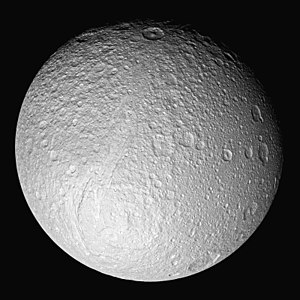 | |
| Discovery | |
|---|---|
| Discovered by | G. D. Cassini |
| Discovery date | March 21, 1684 |
| Designations | |
| Alternate name | Saturn III |
| Adjective | Tethyan |
| Semi-major axis | 294 619 km |
| Eccentricity | 0.000 1[1][2] |
| Orbital period | 1.887 802 d[2] |
| Inclination | 1.12° (to Saturn's equator) |
| Satellite of | Saturn |
| Physical characteristics | |
| Dimensions | 1080.8 × 1062.2 × 1055 km[3] |
| Mean radius | 533.00 ± 0.70 km (0.083 Earths)[4] |
| Mass | (6.174 49 ± 0.001 32) × 1020 kg[4][5] (1.03 × 10-4 Earths) |
| Mean density | 0.973 5 ± 0.003 8 g/cm³ [4] |
| Equatorial surface gravity | 0.145 m/s2 |
| Escape velocity | 0.393 km/s |
| Rotation period | synchronous |
| Axial tilt | zero |
| Albedo | 1.229 ± 0.005 (geometric)[6] |
| Temperature | 86 K |
| Apparent magnitude | 10.2 [7] |
| | |
Tethys (pronounced /ˈtiːθɨs/, /ˈtɛθɨs/,[8] or as Greek Τηθύς) is a moon of Saturn that was discovered by Giovanni Domenico Cassini in 1684.[9]
Name
Tethys is named after the titan Tethys of Greek mythology. It is also designated Saturn III or S III Tethys.
Cassini named the four moons he discovered in 1671–1684 (Tethys, Dione, Rhea and Iapetus) Sidera Lodoicea ("the stars of Louis") to honour king Louis XIV. Cassini found Tethys using a large aerial telescope he set up on the grounds of the Paris Observatory[10]. By the end of the seventeenth century, astronomers fell into the habit of referring to them and Titan as Saturn I through Saturn V (Tethys, Dione, Rhea, Titan, Iapetus). Once Mimas and Enceladus were discovered in 1789, the numbering scheme was extended to Saturn VII by bumping the older five moons up two slots. The discovery of Hyperion in 1848 changed the numbers one last time, bumping Iapetus up to Saturn VIII. Henceforth, the numbering scheme would remain fixed.
The names of all seven satellites of Saturn then known come from John Herschel (son of William Herschel, discoverer of Mimas and Enceladus) in his 1847 publication Results of Astronomical Observations made at the Cape of Good Hope [11], wherein he suggested the names of the Titans, sisters and brothers of Kronos (the Greek analogue of Saturn), be used.
The correct adjectival form of the moon's name is Tethyan, although other forms are also used.
Physical characteristics
Tethys is an icy body similar in nature to Dione and Rhea. The density of Tethys is 0.97 g/cm³, indicating that it is composed almost entirely of water-ice. The Tethyan surface is heavily cratered and contains numerous cracks caused by faults in the ice. Its surface is one of the most reflective (at visual wavelengths) in the solar system, with a visual albedo of 1.229.[6] This very high albedo is the result of the sandblasting of particles from Saturn's E-ring, a faint ring composed of small, water-ice particles generated by Enceladus' south polar geysers.
There are two different types of terrain found on Tethys, one composed of densely cratered regions and the other consisting of a dark colored and lightly cratered belt that extends across the moon. The light cratering of this second region indicates that Tethys was once internally active, causing parts of the older terrain to be resurfaced. The exact cause of the darkness of the belt is unknown but a possible interpretation comes from recent Galileo orbiter images of Jupiter's moons Ganymede and Callisto, both of which exhibit light polar caps that are made from bright ice deposits on pole-facing slopes of craters. From a distance the caps appear brighter due to the thousands of unresolved ice patches in small craters present there. The Tethyan surface may have been formed in a similar manner, consisting of hazy polar caps of unresolved bright ice patches with a darker zone in between.

The western hemisphere of Tethys is dominated by a huge impact crater called Odysseus, whose 400 km diameter is nearly 2/5 of that of Tethys itself. The crater is now quite flat (or more precisely, it conforms to Tethys' spherical shape), like the craters on Callisto, without the high ring mountains and central peaks commonly seen on the Moon and Mercury. This is most likely due to the slumping of the weak Tethyan icy crust over geologic time.
The second major feature seen on Tethys is a huge valley called Ithaca Chasma, 100 km wide and 3 to 5 km deep. It runs 2000 km long, approximately 3/4 of the way around Tethys' circumference. It is thought that Ithaca Chasma formed as Tethys' internal liquid water solidified, causing the moon to expand and cracking the surface to accommodate the extra volume within. The subsurface ocean may have resulted from a 2:3 orbital resonance between Dione and Tethys early in the solar system's history that led to orbital eccentricity and tidal heating of Tethys' interior. The ocean would have frozen after the moons escaped from the resonance.[12] Earlier craters that formed before Tethys solidified were probably all erased by geological activity before then. There is another theory about the formation of Ithaca Chasma: when the impact that caused the great crater Odysseus occurred, the shockwave traveled through Tethys and fractured the icy, brittle surface on the other side. The Tethyan surface temperature is -187°C.
Trojan moons
The co-orbital moons Telesto and Calypso are located within Tethys' Lagrangian points L4 and L5, 60 degrees ahead and behind Tethys in its orbit respectively.
Flybys
The Cassini orbiter performed a close targeted flyby of Tethys on September 23, 2005 at the distance 1500 km. Although Cassini will continue to observe Tethys at moderate distances during its extended mission, there are no plans for further close fly-bys.

0 comments:
Post a Comment